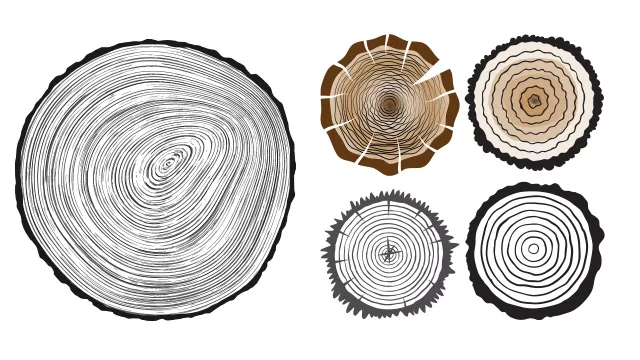This activity will teach students how to make a print and count tree rings.

Lesson Plan
Earth-observing satellites like the Joint Polar Satellite System (JPSS) help manage wildfires. JPSS satellites observe every place on Earth at least twice a day, as each satellite orbits the globe from the North Pole to the South Pole 14 times daily. The Visible Infrared Radiometer Suite (VIIRS) is like the eyes of the satellite. It gives us images of hurricanes, floods, dust storms, cloud patterns and ocean color. It also helps locate and map wildfires, and track wildfire smoke. When protecting lives and property from wildfires time is of the essence. JPSS gives us earlier and more targeted warnings of wildfires. These warnings can help with evacuations and emergency preparations. Scientists use JPSS data to detect and track wildfires, especially in remote regions. For example, JPSS satellites monitored more than 150 wildfires burning across Alaska in June and July 2022. The data were used to map the fires and track their development. The VIIRS Day Night Band is useful for tracking wildfire smoke at night. Smoke can affect temperature forecasts, visibility for pilots, and air quality. JPSS maps were used for fires in Northern California, Oregon, and Seattle in September of 2022.
Although fires can be started by lightning and other natural causes, most wildfires (85%) are caused by people. The United States has lost 29.7 million acres of trees due to forest fires since 2001. Fire safety is an important part of forest conservation.
Did you know?: The Joint Polar Satellite System has a sensor that tells us how strong a fire is and where it is located.
Materials
You will need
- Paint
- Paint brush or foam brush
- 7 to 8 inch natural wood slices – these round, pine, slices can be purchased at most craft stores
- Roller, rolling pin, or squeegee
- Paper towels
- Spray bottle filled with water
- Printed copies of the attached worksheet on thick paper or card stock
Exploring Tree Rings with Printing
Before Presenting this Activity: Prepare the sliced wood rounds a day or two before doing the activity by spraying them with water to raise the grain. The wood will start out smooth to the touch but if you mist it with water and let it dry a few times the texture of the rings will become easier to feel. Once you can feel the rings with your fingertips, you are ready to paint.
- Explain that JPSS is a polar-orbiting satellite system monitoring the Earth, and that JPSS helps track wildfires and smoke.
- Mist the surface of the wood lightly with water to prevent too much paint from absorbing into the wood so you can reuse it. The surface should be slightly moist but not damp or wet. Gently blot it with a paper towel as needed.
- Give each participant a very small (dime to quarter) sized dollop of paint. The most important part of this activity’s success is to limit the amount of paint used. A little goes a long way!
- Brush the paint lightly over the wood. Make sure you are spreading it thinly and evenly.
- Once the wood is coated in a thin layer of paint, gently lay the paper over the center of the wood.
- Use a roller, rolling pin, squeegee, or hands to press the paper over the wood and absorb the paint. For best results, smooth the paper in the same direction the entire time. A rolling pin or squeegee with even pressure gives the clearest results.
- Gently peel the paper off the wood and leave it to dry.
- Before starting another print, use paper towels or other sheets of paper to try to get as much paint off of the wood as you can so you can reuse the wood many times.
- Once the paint is dry, count the rings of the tree to find out how old it was.
How Old Was the Tree?
After you have printed your wood slices, count the number of rings and fill in the blanks below.
I counted ______ number of rings, this tree is ______ years old.
